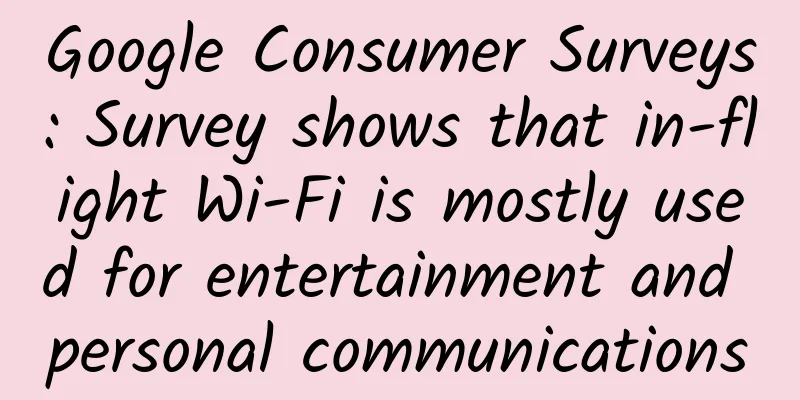Google Consumer Surveys: Survey shows that in-flight Wi-Fi is mostly used for entertainment and personal communications

|
As in-flight Wi-Fi becomes more popular, passengers' usage of this service is also increasing. However, the user habits of this service have yet to be understood and studied. Therefore, we surveyed the habits and usage patterns of users in the United States who have used in-flight Wi-Fi to better understand how they use this service. The study was conducted in the form of a questionnaire through Google Consumer Surveys. Respondents were asked to answer a screening question first: " Have you ever used the in-flight Wi-Fi service? " Respondents who chose " yes " would then go on to answer the purpose of their use of the service, such as work, entertainment or communication. We came to an interesting conclusion: most American passengers use in-flight Wi-Fi for entertainment and personal communication , with only a small number saying it is for work. Note: This survey was conducted on Google Consumer Surveys between April 15 and 17, 2014, using multiple-choice questions among Internet users in the United States. A total of 1,234 respondents answered the screening questions, of which approximately 250 met the criteria and continued to answer. We categorized the respondents in this survey by gender, age, geographic location, and other criteria as follows. Screening question: Interestingly, about 18% of US users said they had used in-flight Wi-Fi, which is already high, but there is still a lot of room for improvement. Key Findings: The majority (60%) of US passengers use inflight Wi-Fi for entertainment and personal communications. By gender: Men use in-flight Wi-Fi mainly for work, while women use it more for entertainment and communication. Due to the small scale of the survey, the behavioral differences between different genders need further research. By age: Young people mainly use the in-flight Wi-Fi to connect with friends on the ground. Maybe Gogo should consider launching a dedicated chat package. By region: There are no significant differences due to the small survey sample and margin of error. By urban and suburban areas: Urban users mainly use in-flight Wi-Fi for work. By income: American passengers with annual salaries between $75,000 and $100,000 mainly use in-flight Wi-Fi for work. (Compiled by Sylvia) via: traveldaily |
<<: Four major trends in the online travel industry
>>: CNNIC: Analysis of online banking users: middle-aged and elderly people trust banks more
Recommend
Cordyceps sinensis cannot be drunk directly in water
Many people should be very familiar with the medi...
Effects and eating methods of palm ginseng
Palm ginseng, also known as Buddha's hand gin...
The efficacy and function of black skin trauma
Black skin trauma is rich in nutritional value an...
Pufferfish: We don’t produce toxins, we are just the “carriers” of toxins
When it comes to pufferfish, gourmets must have a...
World Rivers Day | Why is the Yangtze River called a "Jiang" and the Yellow River called a "He"? You will learn a lot after reading this!
Jiang and He are common place names and are names...
The efficacy and function of Hibiscus tiliaceus
There are so many medicinal herbs in the world, a...
The efficacy and function of Tibetan Panax notoginseng
The medical value of Tibetan Panax notoginseng is...
It’s not enough to just capture the carbon, you also have to “lock it up”!
You know, it is difficult to preserve the gas in ...
Why is Coke considered a happy drink but Sprite is not?
Audit expert: Peng Guoqiu Deputy Chief Physician,...
8D Magic Chongqing: Our reputation as the “City of Bridges” is well deserved!
Chongqing, as one of the top ten popular tourist ...
What are the effects and functions of raw white peony root?
Each plant has its own effects and functions, and...
Are patterned ceramic tableware toxic? Can they really not be used anymore?
"Patterned ceramic tableware is poisonous, d...
What are the effects of white poria powder
Many people are very worried about problems with ...
Will eating carrots often make you black? Answer: You don’t eat enough to turn black!
Produced by: Science Popularization China Author:...
What are the effects and functions of Tianjihuang
Tianjihuang is a kind of traditional Chinese medi...









